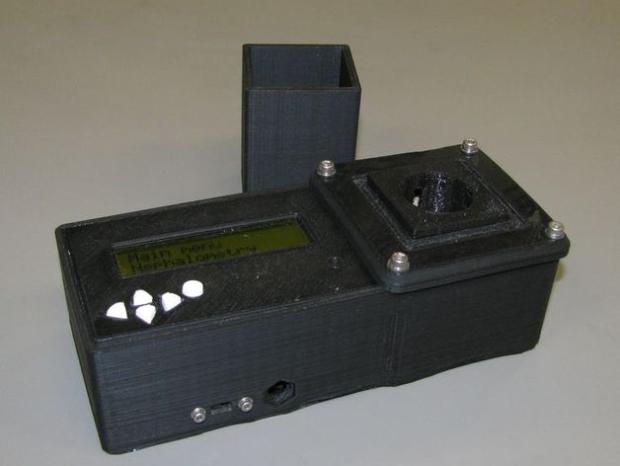3D Printed Water Quality Testing Device Offers Affordability and Portability to Test Potability
 The issue of a plentiful water supply is as old as the origins of man. Water represents the cycle of life, and we are in a perpetual ongoing exercise worldwide to find it, cultivate its source, and maintain supplies for people on a permanent basis.
The issue of a plentiful water supply is as old as the origins of man. Water represents the cycle of life, and we are in a perpetual ongoing exercise worldwide to find it, cultivate its source, and maintain supplies for people on a permanent basis.
Although most of us are aware of the issue on a general level, we take for granted brushing our teeth without worrying, making coffee, having endless ice water from the fridge, and, yes — wasting lots of it. If you’ve ever been to another country where it’s an issue, things get very inconvenient real fast. I experienced this twice — while on a backpacking trip where we ran out of water and had to use purifying tablets to drink out of springs — and another time while visiting my dad who had decided to take up residence as an expat in Mexico just for fun. Each time when I got home, I felt the joy of being able to drink water out of the tap, shower, brush my teeth without using bottled water… oh, glorious freedom! And those were just mild inconveniences.
The problem with water in challenged countries (and states, even in the US) is simple: When we have a water source, the pathogens in the water have to be eliminated. Without water, people die. Without clean water, people are at great risk for getting sick and dying. And as Dr. Joshua M. Pearce of Michigan Technological University points out, previous methods for providing clean water are very expensive.
He is working to change that with a process called solar water disinfection (SODIS), which is an extremely affordable water purification system using table salt to reduce poor water quality in water containing clay, and eliminate sickness for those drinking it. In his study, ‘Optimizing the Solar Water Disinfection (SODIS) Method by DecreasingTurbidity with NaCl,’ Dr. Pearce and researcher Brittney Dawney state that ‘solar water disinfection (SODIS) has proven to be effective at reducing diarrheal incidence in epidemiological intervention studies.’ In conjunction with this, they have created a realistic, portable device to test the safety of water.
The study investigates the use of common table salt (NaCl) to reduce the turbidity of water containing clay particles.
Imagine if your goal during the day — aside from eating — was simply to find something to drink that wouldn’t make you sick. That puts things in perspective, when your greatest dietary challenge today might be fitting in time to run through a drive-through and fix the problem by pulling out your debit card and giving an order.
According to water.org, more than 3.4 million people die each year from water-, sanitation-, and hygiene-related causes. Nearly all deaths, 99 percent, occur in the developing world. In Africa, hundreds of millions of people lack a clean water supply.
And while many of us think of Californians as all tanned, beautiful, and cruising past tall palm trees in gleaming sports cars, this state has a terrible water shortage, as well as degraded water and bad air quality — all contributing to the issue of water supply in a state known for its beauty on every level. Some might say that citizens pay a price to live there, but with the new water testing product being developed by Dr. Pearce and his team from the Department of Materials Science and Engineering at Michigan Tech, this problem may be meeting a solution.
Portability and affordability are big factors in providing a viable testing source for water. Dr. Pearce and his team, operating in Pearce’s area of expertise, open-source technology and sustainability programs, have designed a new low-cost open sourced water testing platform. Not surprisingly, Arduino software is housed within the 3D printed device, which lends itself to easy prototyping and manufacturing, and is low-cost.
Using OpenSCAD modeling, Dr. Pearce and his team designed the testing device with the Arduino, microcontroller, and LED display shield, using GitHub firmware. The case for the testing device was produced with a RepRap 3D printer.
Tell us what you think about this latest effort to provide clean water through 3D printing in the 3D Printing Water Testing Device forum over at 3DPB.com.
Dr. Joshua M. Pearce earned a Ph.D. in Materials Engineering from the Pennsylvania State University, and has a great deal of experience in developing sustainability programs. At his current position as Associate Professor in the Department of Materials Science & Engineering and in the Department of Electrical & Computer Engineering at the Michigan Technological University, Pearce is researching open source technology to use it in applications regarding sustainability and poverty reduction.
Subscribe to Our Email Newsletter
Stay up-to-date on all the latest news from the 3D printing industry and receive information and offers from third party vendors.
Print Services
You May Also Like
New Business: Temporary, Migratory, & Modular 3D Printed Architecture
If we look at potentially emerging 3D printing businesses, then architecture has not been fully explored. Yes, there is a lot of house 3D printing going on worldwide. From deployable...
3D Printing News Briefs, April 19, 2025: Material Extrusion Standard, Metal Powder, & More
In today’s 3D Printing News Briefs, we’re covering a proposed standard for material extrusion, before moving on to business and metal powder. We’ll end with a commercial store’s robotic 3D...
Japan Unveils World’s First 3D Printed Train Station
Japan is now home to what we believe is the world’s first train station built with 3D printing technology. Located in Arida City, just south of Osaka, the new Hatsushima...
restor3d Raises $38M to Expand 3D Printed Orthopedic Implants
Backed by $38 million in new funding, restor3d is pushing ahead with the launch of four personalized implant lines, set to roll out in 2025 and 2026. This latest venture...



























